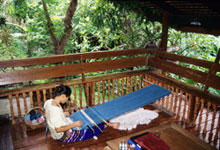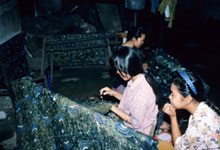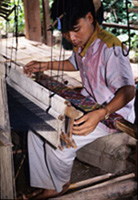The Anthropological Study of Humans and Textiles
Research Objectives
![[img]](/sites/default/files/research/activity/project/corp/img/core_sekimoto11-001.jpg) This project investigates the relationship between humans and material things, with a primary focus on cloth. Each participant of this project is an experienced researcher on traditional textiles and related crafts at various field sites, mainly in Asia, and has published the results of their individual research. In this project, we will hold international conferences and workshops, and publish a work that will synthesize the past research results of project members, and will set a new standard for anthropology in this field. Through these activities, we aim to construct a new field of inquiry for anthropological research on the relationship of humanity to material things, using cloth as our starting point.
This project investigates the relationship between humans and material things, with a primary focus on cloth. Each participant of this project is an experienced researcher on traditional textiles and related crafts at various field sites, mainly in Asia, and has published the results of their individual research. In this project, we will hold international conferences and workshops, and publish a work that will synthesize the past research results of project members, and will set a new standard for anthropology in this field. Through these activities, we aim to construct a new field of inquiry for anthropological research on the relationship of humanity to material things, using cloth as our starting point.
By examining and synthesizing case studies of the production, circulation, and consumption of cloth in contemporary Asia, we will explore continuities and changes from the past. We aim to develop new, concrete perspectives on the materiality of humans, environmental constraints, practical and situational knowledge, local landscapes, and networks of relationships between people and things.
Themes and Activities
The project leader and other participants have presented the results of their research on traditional textiles and related crafts in various parts of Asia. These results are the product of long-term cooperation with local researchers and persons involved with textiles in China, Indonesia, Thailand, Laos, the Philippines, South Asia and Turkey. We will, via our studies of cloth, establish a new field for anthropological research: relationships between people and things in the contemporary world. Together with ongoing conferences in which each participant discusses research results of his/her own, we will, as necessary, carry out supplementary field research, using external funding. Our plans call for expanded cooperation between anthropologists, social and economic historians, and scholars in other specialties. The target of our cooperation will include a wide variety of individuals involved in textile production, circulation, and fashion, artists, and semi-professional textile lovers. We will, as appropriate, create occasions for interaction with these individuals to broaden the scope of our research. We will be placing particular weight on the need to stimulate the thinking and ambition of younger researchers. Cloth ranks with foodstuffs and beverages as a human universal intimately connected with the human body. Where, however, foodstuffs and beverages are consumed and absorbed into the body itself, cloth becomes a second skin in direct contact with the skin beneath it. This combination of intimacy and externality makes cloth a particularly interesting topic for investigations of people and things. Earlier research on material artifacts has focused on human activity, how artifacts are made and used. Now, however, the flourishing study of material culture around the world has shifted our attention to the action of material artifacts that influence humans. Recognizing the material and visceral nature of the human body itself, we no longer draw a rigorous distinction between people and things. Criticizing excessive anthropocentrism (that is, regarding the human spirit and reason to be central) and elucidating a world of mutual interpenetration and fusion of things, people and images are among our research objectives. The comparative study across time and space of cloth, a material at once familiar and universal, is a useful means of avoiding overly speculative research.
Cloth ranks with foodstuffs and beverages as a human universal intimately connected with the human body. Where, however, foodstuffs and beverages are consumed and absorbed into the body itself, cloth becomes a second skin in direct contact with the skin beneath it. This combination of intimacy and externality makes cloth a particularly interesting topic for investigations of people and things. Earlier research on material artifacts has focused on human activity, how artifacts are made and used. Now, however, the flourishing study of material culture around the world has shifted our attention to the action of material artifacts that influence humans. Recognizing the material and visceral nature of the human body itself, we no longer draw a rigorous distinction between people and things. Criticizing excessive anthropocentrism (that is, regarding the human spirit and reason to be central) and elucidating a world of mutual interpenetration and fusion of things, people and images are among our research objectives. The comparative study across time and space of cloth, a material at once familiar and universal, is a useful means of avoiding overly speculative research.  This research project aims at more than the recording and preservation of traditional textiles and the weaving and dyeing techniques employed in them. Our explorations of the relationships of cloth to humanity and how cloth affects human lives will include comparative research on the production, circulation and consumption of cloth in the modern global market. Neither will we focus excessively on either the production side or consumption side of cloth. Much research has already been carried out separately on the consumption of cloth as a way of covering and adorning the body, on one hand, and on its production through interactions between humans and material objects, on the other. Our aim is a new research domain with a more integrated approach to the study of the production and consumption of cloth from the perspective of exploring interactions and interpenetrations between cloth and humanity.
This research project aims at more than the recording and preservation of traditional textiles and the weaving and dyeing techniques employed in them. Our explorations of the relationships of cloth to humanity and how cloth affects human lives will include comparative research on the production, circulation and consumption of cloth in the modern global market. Neither will we focus excessively on either the production side or consumption side of cloth. Much research has already been carried out separately on the consumption of cloth as a way of covering and adorning the body, on one hand, and on its production through interactions between humans and material objects, on the other. Our aim is a new research domain with a more integrated approach to the study of the production and consumption of cloth from the perspective of exploring interactions and interpenetrations between cloth and humanity.
References
1.SEKIMOTO Teruo. 2011, How Cloth as an Object Works on Us., Minpaku Monthly No.404. [PDF: 91.4KB]
Results in Fiscal 2010
 This project was launched in January, 2011. Preparations are underway for joint research meetings, workshops, international symposia, and publication of results.
This project was launched in January, 2011. Preparations are underway for joint research meetings, workshops, international symposia, and publication of results.




